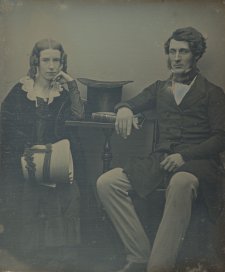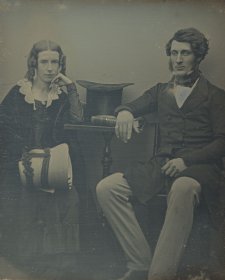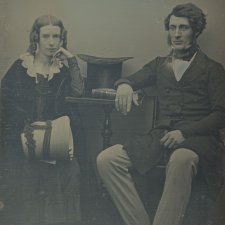Sir George Grey (1812–1898), soldier, explorer and colonial administrator, arrived in Western Australia in 1838 to conduct an expedition by which he proposed to locate a site for settlement on the north-west coast. The attempt failed, but he remained in the colony and was appointed resident magistrate at Albany in August 1839. Later that year he married Eliza Spencer (c. 1819–1898). During his time in Albany, Grey studied local Aboriginal culture, publishing his findings as Vocabulary of the Dialects spoken by the Aboriginal Races of South-Western Australia. Recalled to England, he produced an account of his Western Australian expeditions before being appointed Governor of South Australia in October 1840. In South Australia he introduced drastic and much-resented spending cuts, though over five years he nearly balanced the colony’s budget. His intractability marred his subsequent two terms as Governor of New Zealand – from 1848 to 1853 and again from 1861 to 1868 – and his term as Governor of the Cape Colony (between 1854 and 1861). His approach to his marriage was similarly austere, such that when Eliza, who was never reconciled to colonial life, confessed her unhappiness to a male acquaintance, Grey insisted on a separation. A reconciliation in 1896 was unsuccessful and they both died, after separating again, in late 1898.
Purchased 1999
A portrait of explorer and colonial administrator, Sir George Grey, by artist Theresa Walker, created in 1845. It is a cast wax medallion mounted in a circular wooden frame, measuring 19 cm in height and width.
Grey's profile from the chest up is depicted in a similar style to an ancient coin, embossed in creamy off-white wax relief. He faces to the left. His hair is thick with a slight wave, swept up off his forehead and cropped short at the back with sizable sideburns in the fashion of the time. He has a high forehead, strong nose and full lips over a defined chin. His jacket has a rigid, high collar up to his chin, epaulettes on the shoulders and neat buttons down the front, suggesting an official uniform.
Light touching the high relief areas creates a bright sheen of white across the forehead, bridge of the nose and buttons on his jacket.
Capitalised text around the top half of this medallion reads: THE PORTS OF SOUTH AUSTRALIA DECLARED FREE, with text at the base of the medallion reading: July 3rd 1845. The wax piece is positioned in a thin circle of lightly tarnished gold within a circular frame of dark brown polished wood. There is a small metal ring in the top centre for display.
Audio description written and voiced by Alana Sivell, 2021



On one level The Companion talks about the most famous and frontline Australians, but on another it tells us about ourselves.



Dr Sarah Engledow explores the lives of Sir George Grey and his wife Eliza, the subjects of a pair of wax medallions in the National Portrait Gallery's collection.



'I have just been to my dressing case to take a peep at you.